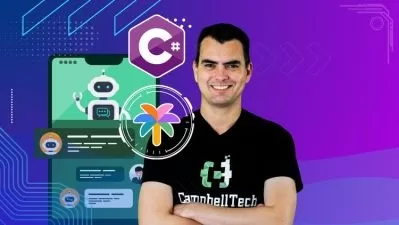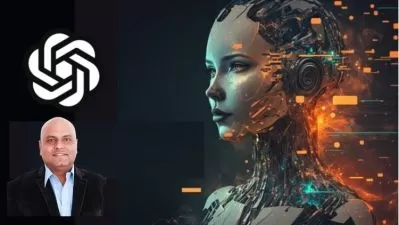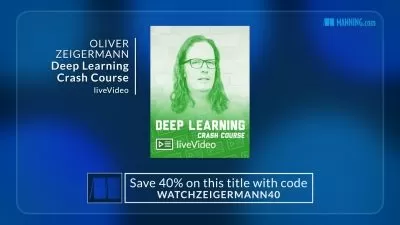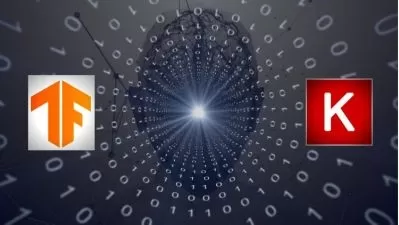Applied Deep Learning & Neural Network: Practical AI Mastery
EDUCBA Bridging the Gap
10:56:00
Description
Embark on a Journey to AI Mastery with Practical Deep Learning and Neural Network Expertise
What You'll Learn?
- Grasp Fundamental Concepts: Understand the foundational principles of machine learning, delve into popular methods, and explore the core ideas behind DL
- Hands-on Coding Experience: Gain practical coding skills using platforms like Jupyter Notebooks, Google Colab, and PyTorch, applying theoretical knowledge
- Neural Network Proficiency: Develop a deep understanding of neural networks, their structures, and applications, laying the groundwork for advanced topics
- Transfer Learning Applications: Explore transfer learning, applying pre-trained models to new tasks, and work with datasets like CIFAR-10
- Text-Based Applications: Extend skills to text classification and generation, harnessing the power of convolutional neural networks, transformer architecture
- Text Translation and Beyond: Master text translation using encoder-decoder architectures and explore diverse applications, including tabular data prediction
- Real-World Project Implementation: Apply acquired knowledge to real-world projects, such as image classification and text translation, honing skills
- Practical Recommendations: Benefit from insights into best practices, recommendations, and efficient learning strategies, ensuring a productive understanding
- By the end of the course, students will possess the practical skills and theoretical knowledge necessary to navigate the dynamic landscape of deep learning
Who is this for?
What You Need to Know?
More details
DescriptionEmbark on a transformative learning experience that demystifies the complex world of deep learning. This hands-on course is designed to equip you with practical skills, enabling you to navigate the realms of machine learning and dive deep into the applications of neural networks.
Embark on a comprehensive exploration of deep learning in our hands-on course. Begin with an introduction to the practical aspects of deep learning, paving the way for a profound understanding of its applications.
Discover the fundamental principles of machine learning in Lecture 2, setting the stage for an in-depth journey into the intricacies of deep learning methodologies. Gain insights into popular machine learning methods and their relevance in real-world scenarios.
As you progress, delve into the core concepts of deep learning, understanding its definition, unique features, and widespread applications across various domains. Explore recommendations and best practices for effective learning in the realm of deep learning.
Delve into the basic concepts of deep learning, including perception and the structure of neural networks. Understand the universal approximations theorem, providing a theoretical foundation for the capabilities of deep neural networks.
Practical aspects come to the forefront as you explore where to write code, with a focus on Jupyter Notebooks, Google Colab, and the PyTorch library. Dive into the fundamentals of tensors, gradients, and their applications in machine learning.
Explore a hands-on example with the MNIST dataset, gaining practical experience in working with image data and building neural networks. Transition to transfer learning, understanding its principles and applying them to real-world datasets like CIFAR-10.
Conclude this section by delving into image classification using convolutional neural networks (CNNs) on datasets like CIFAR-10. From data preparation to model training and evaluation, develop the skills needed to apply deep learning to diverse image-based tasks.
Extend your knowledge to text-based applications, starting with text classification using CNNs. Continue with text generation using transformers, gaining insights into their architectures and applications in natural language processing.
Explore text translation using encoder-decoder architectures, covering essential components like attention mechanisms. Develop practical skills in training and evaluating models for various tasks, including tabular data prediction and collaborative filtering for recommendations.
In this comprehensive curriculum, each topic builds upon the last, ensuring a well-rounded understanding of deep learning principles and their practical applications across different domains.
Introduction to Hands-on Deep Learning (Lecture 1): Get ready to immerse yourself in the fascinating field of deep learning. This course goes beyond theoretical concepts, offering a hands-on approach that ensures you not only understand the principles but can apply them effectively.
Understanding Machine Learning (Lecture 2): Before delving into deep learning, lay the groundwork with a comprehensive overview of machine learning. Gain insights into popular methods that form the foundation for advanced concepts explored later in the course.
Foundations of Deep Learning (Lecture 4): Discover the essence of deep learning, unraveling its core principles and unique characteristics. Explore its broad applications, from image and speech recognition to recommendation systems and text processing.
Recommendations and Best Practices (Lecture 6): Benefit from valuable recommendations and best practices that guide your learning journey. Navigate the intricate landscape of deep learning with insights that ensure a fruitful and efficient learning experience.
Basic Concepts of Deep Learning (Lecture 7): Grasp the fundamental concepts that underpin deep learning, including the perception and structure of neural networks. Lay the theoretical foundation for hands-on exercises and practical applications.
Where to Write Code (Lecture 14): Enter the practical realm with guidance on where to write code. Explore platforms like Jupyter Notebooks, Google Colab, and dive into PyTorch, setting the stage for interactive and effective coding experiences.
Tensors, Gradients, and MNIST Example (Lectures 18-22): Build your coding proficiency with a focus on tensors, gradients, and practical examples using the MNIST dataset. Gain hands-on experience in manipulating data and constructing neural networks.
Transfer Learning and Image Classification (Lectures 25-38): Transition into transfer learning and apply it to real-world datasets, such as CIFAR-10. Move beyond theory to practical implementation, including data preparation, model building, and performance evaluation.
Text Classification and Generation (Lectures 47-63): Extend your skills to text-based applications, from classification to generation. Dive into convolutional neural networks for text classification and explore the transformative power of transformer architectures.
Text Translation and Beyond (Lectures 64-81): Master text translation using encoder-decoder architectures and delve into diverse applications, including tabular data prediction and collaborative filtering. The course concludes with a broad understanding of deep learning's versatile applications.
Embark on this enriching journey, where theoretical understanding meets hands-on proficiency, ensuring you emerge with the skills to tackle real-world challenges in the dynamic field of deep learning. Welcome to a course that empowers your journey into the heart of artificial intelligence.
Who this course is for:
- Aspiring Data Scientists: Individuals seeking to enter the field of data science and machine learning, aiming to build practical skills and gain hands-on experience.
- AI Enthusiasts: Those passionate about artificial intelligence, looking to deepen their understanding of deep learning, neural networks, and practical applications in real-world projects.
- Programmers and Developers: Professionals with a programming background interested in expanding their expertise to include deep learning and neural network applications.
- Tech Professionals: Individuals in technology-related fields who want to stay updated with the latest advancements in AI and enhance their proficiency in applied deep learning.
- Students and Researchers: Students pursuing degrees in computer science, engineering, or related fields, as well as researchers interested in practical applications of deep learning techniques.
- Professionals Seeking Career Transition: Individuals aiming to transition into roles focused on machine learning, AI, or data science, and wish to acquire practical skills for successful career shifts.
Embark on a transformative learning experience that demystifies the complex world of deep learning. This hands-on course is designed to equip you with practical skills, enabling you to navigate the realms of machine learning and dive deep into the applications of neural networks.
Embark on a comprehensive exploration of deep learning in our hands-on course. Begin with an introduction to the practical aspects of deep learning, paving the way for a profound understanding of its applications.
Discover the fundamental principles of machine learning in Lecture 2, setting the stage for an in-depth journey into the intricacies of deep learning methodologies. Gain insights into popular machine learning methods and their relevance in real-world scenarios.
As you progress, delve into the core concepts of deep learning, understanding its definition, unique features, and widespread applications across various domains. Explore recommendations and best practices for effective learning in the realm of deep learning.
Delve into the basic concepts of deep learning, including perception and the structure of neural networks. Understand the universal approximations theorem, providing a theoretical foundation for the capabilities of deep neural networks.
Practical aspects come to the forefront as you explore where to write code, with a focus on Jupyter Notebooks, Google Colab, and the PyTorch library. Dive into the fundamentals of tensors, gradients, and their applications in machine learning.
Explore a hands-on example with the MNIST dataset, gaining practical experience in working with image data and building neural networks. Transition to transfer learning, understanding its principles and applying them to real-world datasets like CIFAR-10.
Conclude this section by delving into image classification using convolutional neural networks (CNNs) on datasets like CIFAR-10. From data preparation to model training and evaluation, develop the skills needed to apply deep learning to diverse image-based tasks.
Extend your knowledge to text-based applications, starting with text classification using CNNs. Continue with text generation using transformers, gaining insights into their architectures and applications in natural language processing.
Explore text translation using encoder-decoder architectures, covering essential components like attention mechanisms. Develop practical skills in training and evaluating models for various tasks, including tabular data prediction and collaborative filtering for recommendations.
In this comprehensive curriculum, each topic builds upon the last, ensuring a well-rounded understanding of deep learning principles and their practical applications across different domains.
Introduction to Hands-on Deep Learning (Lecture 1): Get ready to immerse yourself in the fascinating field of deep learning. This course goes beyond theoretical concepts, offering a hands-on approach that ensures you not only understand the principles but can apply them effectively.
Understanding Machine Learning (Lecture 2): Before delving into deep learning, lay the groundwork with a comprehensive overview of machine learning. Gain insights into popular methods that form the foundation for advanced concepts explored later in the course.
Foundations of Deep Learning (Lecture 4): Discover the essence of deep learning, unraveling its core principles and unique characteristics. Explore its broad applications, from image and speech recognition to recommendation systems and text processing.
Recommendations and Best Practices (Lecture 6): Benefit from valuable recommendations and best practices that guide your learning journey. Navigate the intricate landscape of deep learning with insights that ensure a fruitful and efficient learning experience.
Basic Concepts of Deep Learning (Lecture 7): Grasp the fundamental concepts that underpin deep learning, including the perception and structure of neural networks. Lay the theoretical foundation for hands-on exercises and practical applications.
Where to Write Code (Lecture 14): Enter the practical realm with guidance on where to write code. Explore platforms like Jupyter Notebooks, Google Colab, and dive into PyTorch, setting the stage for interactive and effective coding experiences.
Tensors, Gradients, and MNIST Example (Lectures 18-22): Build your coding proficiency with a focus on tensors, gradients, and practical examples using the MNIST dataset. Gain hands-on experience in manipulating data and constructing neural networks.
Transfer Learning and Image Classification (Lectures 25-38): Transition into transfer learning and apply it to real-world datasets, such as CIFAR-10. Move beyond theory to practical implementation, including data preparation, model building, and performance evaluation.
Text Classification and Generation (Lectures 47-63): Extend your skills to text-based applications, from classification to generation. Dive into convolutional neural networks for text classification and explore the transformative power of transformer architectures.
Text Translation and Beyond (Lectures 64-81): Master text translation using encoder-decoder architectures and delve into diverse applications, including tabular data prediction and collaborative filtering. The course concludes with a broad understanding of deep learning's versatile applications.
Embark on this enriching journey, where theoretical understanding meets hands-on proficiency, ensuring you emerge with the skills to tackle real-world challenges in the dynamic field of deep learning. Welcome to a course that empowers your journey into the heart of artificial intelligence.
Who this course is for:
- Aspiring Data Scientists: Individuals seeking to enter the field of data science and machine learning, aiming to build practical skills and gain hands-on experience.
- AI Enthusiasts: Those passionate about artificial intelligence, looking to deepen their understanding of deep learning, neural networks, and practical applications in real-world projects.
- Programmers and Developers: Professionals with a programming background interested in expanding their expertise to include deep learning and neural network applications.
- Tech Professionals: Individuals in technology-related fields who want to stay updated with the latest advancements in AI and enhance their proficiency in applied deep learning.
- Students and Researchers: Students pursuing degrees in computer science, engineering, or related fields, as well as researchers interested in practical applications of deep learning techniques.
- Professionals Seeking Career Transition: Individuals aiming to transition into roles focused on machine learning, AI, or data science, and wish to acquire practical skills for successful career shifts.
User Reviews
Rating
EDUCBA Bridging the Gap
Instructor's Courses
Udemy
View courses Udemy- language english
- Training sessions 81
- duration 10:56:00
- Release Date 2024/04/13





















